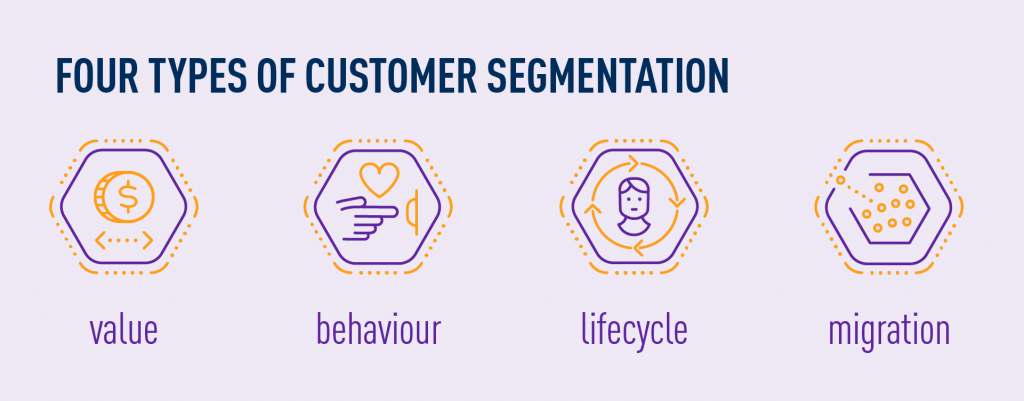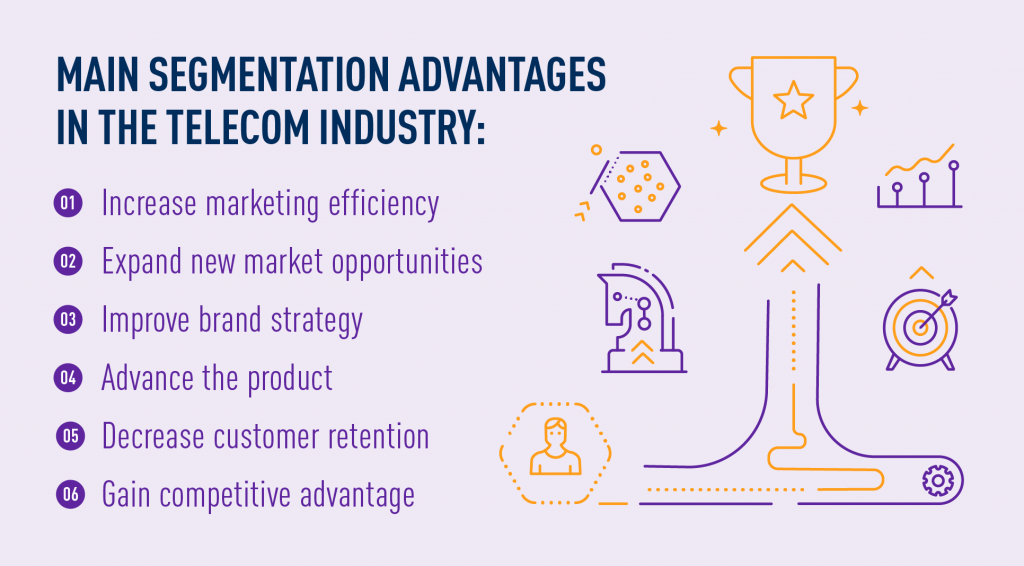Insights
- category:
Customer segmentation advantages in the telecom industry

Telecom companies gather different kinds of data to make sure their services answer customers’ needs. So the service providers must keep the consumers happy and maintain their happiness to make sure that their business will stand out in this super-competitive market. Therefore, boosting customer experience to make marketing more effective is one of the key segmentation advantages in telecom.
Customer segmentation techniques
Customer segmentation groups similar customers to do an in-depth analysis of their behaviour. Customers can be segmented by their industry, product tier or usage level, revenue, employee size, geographical locations, the date they became a customer, channel their contact originated from, buyer persona and ideal customer profile. Grouping by these data points helps companies gain several segmentation advantages in telecoms, such as identifying the ideal customer profiles and determining which types of customers won’t like the specific products or services. The purpose of such segmentation is to identify various groups within the company’s target audience so that marketers can deliver more targeted and valuable messaging.

As market conditions are volatile, companies evaluate the effectiveness of the market segment solution by validating the solution with the help of the market segmentation criteria. Current segmentation trends in the telecommunications sector can be divided into four techniques.
Customer Value Segmentation
Customer loyalty has been termed the most crucial aspect of marketing. The main reason is the 80/20 marketing costs rule, which says, “top 20% profitable customers contribute 80% of a company’s profits and 80% of a company’s costs are contributed by top 20% of unprofitable customers”. Therefore, companies invest significant time and effort to retain customers. Telecom companies incline themselves to segment profitable customers by calculating their value.
The crucial steps involved in customer value segmentation are:
- Calculate the customer value measure for every customer (this is the summary of past and predicted future value of customers),
- Use decile analysis that divides the entire customer base into ten equal-sized groups, also known as deciles,
- Describe customer profiles to monitor their needs carefully and develop a relevant marketing strategy that answers their needs.
Customer Behaviour Segmentation
Over the past years, the number of people using telecom services has drastically increased. To manage such massive amounts of customers and understand their needs, telecommunication companies capture every action performed by customers, building huge repositories containing customers’ behavioural data. As telecom services are used extensively by people in their daily lives, telecom companies are tapping into determining customer needs and developing relevant strategies from the collected customer behavioural data. The usage of customer behavioural data in market segmentation is termed customer behavioural segmentation.
Customer Lifecycle Segmentation
To compete in the market, modern-age telecom companies need to retain customer-centric market segmentation techniques. Understanding customer behaviour and improving customer loyalty play a fundamental role in determining the success of the chosen market segmentation technique. Customer lifecycle segmentation considers a snapshot of the current life stage of customers and performs market segmentation by analysing their needs and interests.

As time passes, people change their social roles. Therefore, it is important to identify and understand the current social roles of customers. There are two types of customer life stages in this type of segmentation: stages related to their customers’ association with the company and stages of their individual lives. Regardless, the premise of this segmentation technique lies in segmenting the varying customer behaviour exhibited at different life stages.
Customer Migration Segmentation
Due to the increased competition in the telecommunications industry, telecom companies are experiencing a high customer churn rate. Such high levels of customer attrition have negative impacts on various aspects of a telecom company. Some impacts include loss of average revenue per customer, decreasing sales and profit, and difficulty acquiring new customers. Owing to these reasons, modern telecom companies incline themselves to understand and analyse the plausible factors that cause customer defection. This has led to the growing importance of customer migration behaviour.

In customer migration segmentation, the customer value measure of each customer is observed at various time frames. It is very common for customers to increase or decrease their loyalty along the way. Therefore, customers can migrate between different segments, and customer satisfaction and loyalty patterns can be identified. Such identification of satisfaction and loyalty patterns can help companies to predict churn before it occurs. Therefore, telecom companies can design and develop compelling activities for customers who have a high probability of switching to other competing companies.
Main segmentation advantages in the telecom industry
Segmenting the customer base and analyzing the performance of those segments can improve the company’s marketing, sales and customer service efforts. Here are a few of the main segmentation advantages in the telecom industry.

Marketing efficiency
This is the biggest benefit of well-implemented customer segmentation. By better recognizing customers’ needs, marketers can identify more effective tactics for reaching them. Marketing efforts became even more effective because of improving customer interactions and experience with the company. Targeted marketing allows for better returns on investment and wasting less money on marketing that reaches the wrong audience.
New market opportunities
During the process of customer segmentation, a new market segment may have been identified. In turn, it can alter the whole marketing focus and strategy to fit. What’s better is that the more targeted marketing is, the better leads can be gathered. Reaching the right people can ensure that the company stands out. Similarly, any segmentation research may help recognize areas of the market that hadn’t been the company’s focus yet. This might lead to new products explicitly designed for these markets.

Better brand strategy
Once the key customers’ motivators are identified, products can be branded appropriately. The goal of market segmentation is not only to reach the targeted audience but also to see the true value of the company thanks to the marketing that speaks to them. Promoting the product with a well-adjusted brand strategy allows for putting the company’s head above competitors.
Improving the product
Knowing who wants to buy the product and what their needs help differentiate the company as the best solution on the market. The result of such practice will be increased satisfaction and better performance against competitors. The benefits also extend beyond core product offerings since any insights allow companies to offer better customer support, professional services, and any services that guarantee a complete customer experience.
Lower customer retention
Thanks to customer segmentation, marketers can identify customers who require extra attention, those that churn quickly, and those with the highest potential value. It can also help create targeted strategies that capture customers’ attention and create positive, high-value experiences with the company.
Competitive advantage
With the amount of competition in the telecom sector, the combination of market segmentation techniques can ensure revenue streams. For instance, by combining geographical segmentation and behavioural segmentation, companies can gain insights into the customers’ behavioural trends located at different geographical locations.

How can TASIL help in achieving segmentation advantages in telecom?
In today’s competitive market, companies need to implement various tactics to ensure that their attempts aren’t going to waste. The key to all these marketing efforts is data collected from the consumers. Understanding, managing and applying this data allows for assessing marketing’s successes and failures while also planning the strategy. With the right understanding of the customer segmentation models, telecom companies can suitably develop their strategy to make sure it works.
Achieving segmentation advantages in telecom is much easier with TASIL. Our tool allows you to use different segments for marketing campaigns to be more personalized and successful. For example, you can target your audience with segments, group customers based on demographic data, target customers from your email marketing list, or combine all these tactics for better results.
Do you know how much your data is worth? Estimate data value here.



